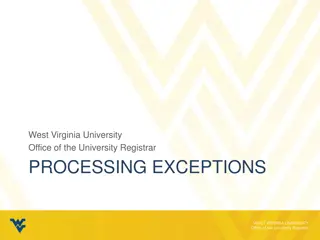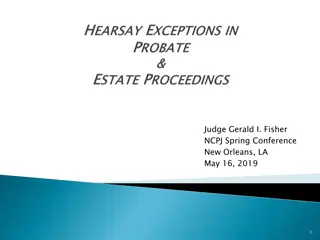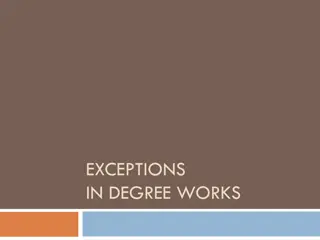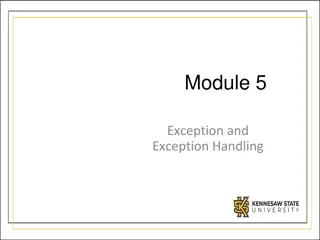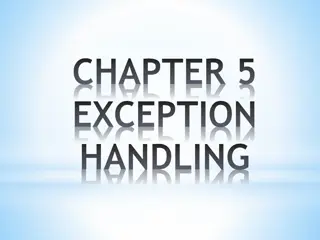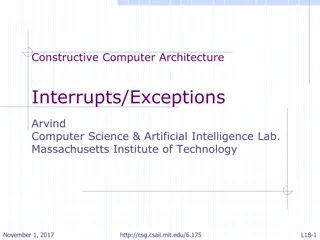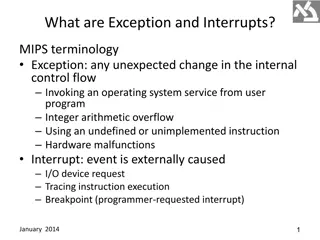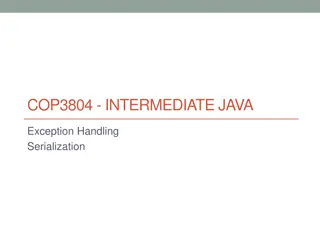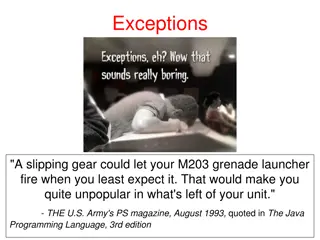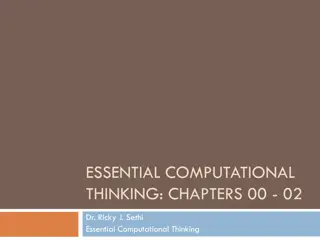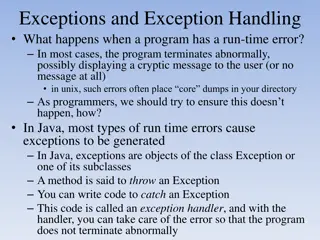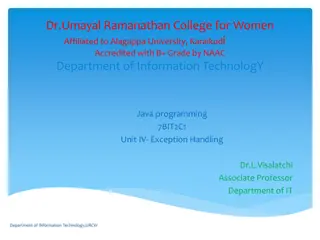Understanding Exceptions in Computer Science
Errors in programming, such as syntax, semantic, runtime, and logical errors, can disrupt the execution of a program. Syntax errors relate to grammatical violations, semantic errors occur when statements lack meaning, and runtime errors happen during program execution due to illegal operations. By identifying and handling these errors effectively, programmers can ensure the proper functioning of their applications.
Download Presentation

Please find below an Image/Link to download the presentation.
The content on the website is provided AS IS for your information and personal use only. It may not be sold, licensed, or shared on other websites without obtaining consent from the author. Download presentation by click this link. If you encounter any issues during the download, it is possible that the publisher has removed the file from their server.
E N D
Presentation Transcript
CHAPTER 10 EXCEPTIONAL HANDLING
XI Computer Science (083) Board : CBSE Unit 2: Computational Thinking and Programming Courtesy CBSE
CHAPTER 10 EXCEPTIONAL HANDLING
ERRORS Error is a abnormal condition whenever it occurs execution of the program is stopped. any issue that arises unexpectedly that cause a computer to not function properly. Computers can software errors or hardware errors. An error is a term used to describe encounter either
ERRORS Errors are mainly classified into following types. 1. Syntax Errors 2. Semantic Errors 3. Run Time Errors. 4. Logical Errors.
1. Syntax Errors Syntax errors refer to formal rules governing the construction of valid statements in a language. of a programming language are misused i.e., when a grammatical rule of the language is violated. Syntax errors occur when rules
1. Syntax Errors segment, def main() a=10 b=3 print( Sum is ,a+b For instance in the following program : (Colon) Missing ) Missing
2. Semantic Errors Semantics error occur when statements are not meaningful Semantics refers to the set of rules which give the meaning of the statement. For example, Rama plays Guitar This statement is syntactically and semantically correct and it has some meaning.
2. Semantic Errors See the following statement, Guitar plays Rama is syntactically correct (syntax is correct) but semantically incorrect. Similarly, there are semantics rules of programming language, violation of which results in semantical errors. X * Y = Z will result in semantical error as an expression can not come on the left side of an assignment statement.
3. Run Time Errors. A Run time error is that occurs during execution of the program. It is caused because of some illegal operation taking place. For example 1. If a program is trying to open a file which does not exists or it could not be opened(meaning file is corrupted), results into an execution error. 2. An expression is trying to divide a number by zero are RUN TIME ERRORS.
4. Logical Errors. A Logical Error is that error which is causes a program to produce incorrect or undesired output. for instance, ctr=1; while(ctr<10): print(n *ctr)
Exceptions What is an exception? Even if a statement or expression is syntactically correct, it may cause an error when an attempt is made to execute it. Errors detected during execution are called exceptions
Exceptions For Example
HandlingExceptions It is possible to write programs that handle selected exceptions. Look at the following example, which asks the user for input until a valid integer has been entered, but allows the user to interrupt the program (using Control-C or whatever the operating system supports); note that a user-generated interruption is signalled by raising the exception. KeyboardInterrupt
HandlingExceptions For Example
HandlingExceptions The try statement works as follows. First, the try clause (the statement(s) between the try and except keywords) is executed. If no exception occurs, the except clause is skipped and execution of the try statement is finished.
HandlingExceptions The try statement works as follows. If an exception occurs during execution of the try clause, the rest of the clause is skipped. Then if its type matches the exception named after the except keyword, the except clause is executed, and then execution continues after the try statement.
HandlingExceptions The try statement works as follows. If an exception occurs which does not match the exception named in the except clause, it is passed on to outer try statements; if no handler is found, it is an unhandled exception and execution stops with a message as shown above.
The except Clause with No Exceptions You can also use the except statement with no exceptions defined as follows: try: You do your operations here; except: If there is any exception, then execute this block .. else: If there is no exception then execute this block. Contd..
The except Clause with No Exceptions This kind of a try-except statement catches all the exceptions that occur. Using this kind of try-except statement is not considered a good programming practice though, because it catches all exceptions but does not make the programmer identify the root cause of the problem that may occur.
raise statement You can raise an exception in your own program by using the raise exception. code execution and returns the exception back until it is handled. Syntax: Raising an exception breaks current raise [expression1[, expression2]]
Some common exceptions IOError If the file cannot be opened. ImportError If python cannot find the module. ValueError Raised when a built-in operation or function receives an argument that has the right type but an inappropriate value.
Some common exceptions KeyboardInterrupt Raised when the user hits the interrupt key (normally Control-C or Delete). EOFError Raised when one of the built-in functions (input() or raw_input()) hits an end-of-file condition (EOF) without reading any data
CLASS TEST Time: 40 Min Max Marks: 20 1. Explain the types of errors 05 2. What is an exception? Explain in detail 05 3. What is raise? explain in detail 05 4. Explain some of the common built in exceptions provided in python 05







